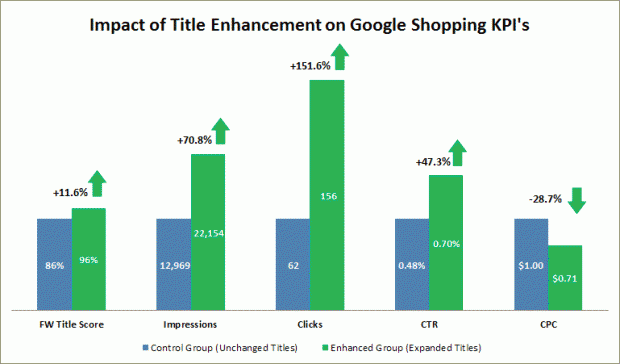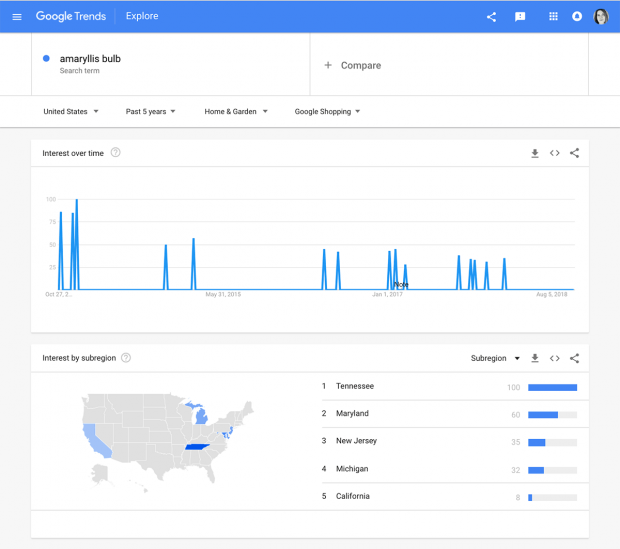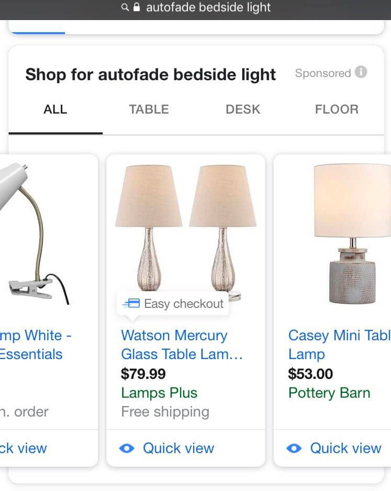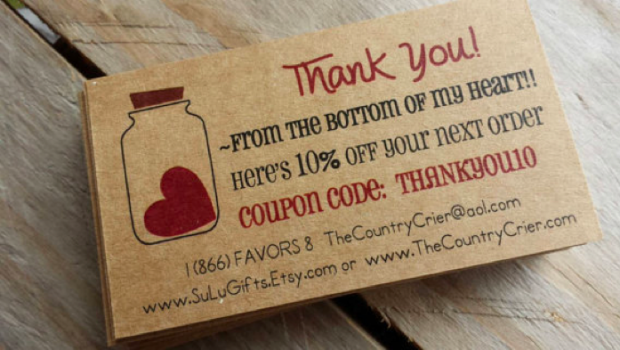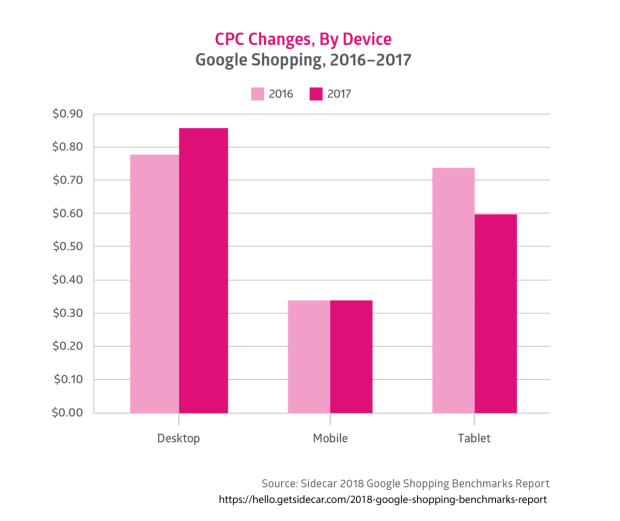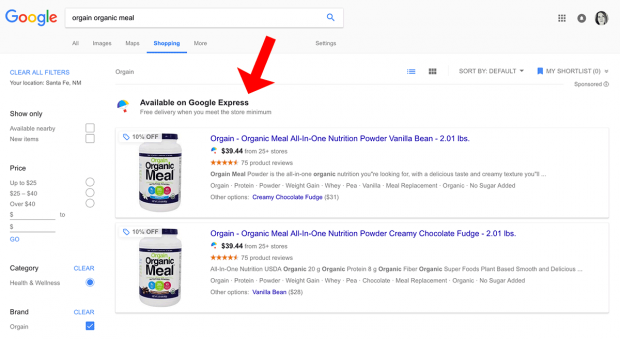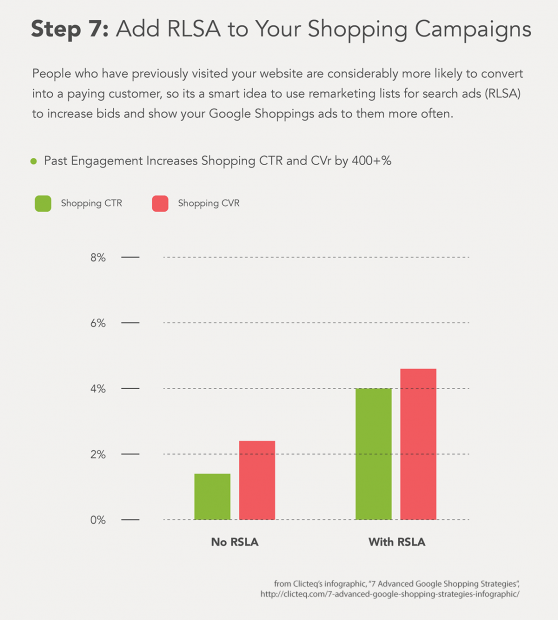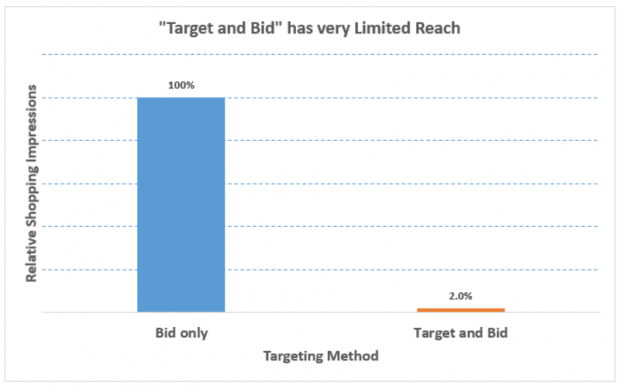Tick, tock. The number of days before the holidays is dwindling, and many consumers have already started their holiday shopping. Is your Google Shopping account ready? If you’re not sure, have no fear. We’ve got five Google Shopping best practices you can apply now to tune up your account – fast.
So be merry. Santa brought you a gift early this year.
1. Optimize the Titles of Your Ads.
This task is so simple, but it can have a very high return. One SEO agency was able to get its client 151.6% more clicks just by optimizing their Shopping ads titles.
Here are a few before and after examples of the titles they changed.
So how do you optimize your own Shopping ads titles? Just keeping everything consistent is a good starting point.
Here is Google’s recommended format:
Google Organic Cotton Men’s T-Shirt – Blue – M
You can learn more about their title format recommendations on their help page. Following their recommendations might get your product feed approved faster, too.
Also consider using a good keyword tool as you optimize your titles. Even tiny differences like “T-Shirt” versus “tshirt” can make a difference.
And don’t hesitate to check Google Trends. It includes trends for product searches.
Here are a few do’s and don’ts for Google Shopping ad titles:
– Don’t capitalize ENTIRE WORDS
– Do strive to use all 150 characters
– Don’t include information that could change, like price, sale price, sale dates, shipping, delivery date, or other time-related information
– Do optimize the first 70 characters of each title, as that may be all some users can see (if they’re on a mobile device, for example)
– Don’t include your company’s name
– Do include brand names in your titles (like “Cuisinart coffee maker” versus “coffee maker”)
Don’t worry if you can’t update all your product titles by Christmas. Just focus on optimizing the titles for your best-selling products. Even getting the top twenty done will help.
2. Sign up for “Shopping Actions”.
Here’s a good tactic to use if your brand or products are relatively unknown. Shopping Actions can showcase your products early on in consumers’ research process, so they can become familiar with your brand before they encounter your competitors.
Shopping Actions is a feature of Google Shopping Ads that lets your products appear beyond just the search page of Google.com, like on the Google Express site and app, and through Google Assistant.
Of course, Shopping Actions can also appear in search results. Like this:
Customers can even buy your products directly in the Google Shopping interface. They’ll get purchase protection, too, which can boost trust and – as a result – sales.
If it all sounds too good to be true, well… there is one major drawback to Shopping Actions: Google won’t share the buyer’s email address with you. Honestly, this is a surprising and disappointing limitation. We’re sure you already know how precious a buyer’s email address is. It’s so valuable that some retailers offer “loss leaders” just to grow their buyers list.
Of course, there are always workarounds. Here are two ideas from our blog on how to get some buyers’ email addresses, and maybe encourage some loyalty, too.
Here’s one:
3. Bid on Mobile.
Short on advertising budget? You might want to focus on mobile clicks. They tend to cost much less.
“But mobile traffic doesn’t convert,” you say. That used to be true, but in 2017 there was a significant shift. Sidecar’s 2018 Google Shopping report revealed a 252% increase in mobile conversion rate for clicks from Google Shopping ads.
So people are indeed researching products and buying them through their phones.
Not only has the mobile conversion rate gone up, but mobile ROAS (return on ad spend) has spiked, too: Sidecar reports “in 2017, desktop ROAS increased only 3% while mobile and tablet ROAS rose 23% and 46%, respectively.”
So if you haven’t tried mobile before for your Google Shopping ads, or if you did try it a few years ago and it didn’t work, it’s time to test it again. You might be able to get a much lower cost per click and still preserve a respectable conversion rate.
And let’s not leave out tablets, either. They’re the ones with the 46% ROAS boost.
4. Leverage Local Searches.
This one’s for those of you with brick and mortar locations. You’ve got a real advantage over your online-only competitors, localized though it may be. So use it.
As Keith Meagher, from Acquisio, and Joe Levinthal, from Seer Interactive, discuss in this post:
Leading up to Christmas, shoppers don’t risk ordering online and instead they tend to go in-store. Ramp up Local Inventory Ads to make sure you’re reaching those last-minute shoppers, telling them you have the product they’re looking for in-stock, and attracting them to your store.
Local ads won’t just show up in text-based local searches, either. They’ll come up for voice searches via Google Assistant, too. They can also appear as catalog style display ads, and can be eligible for Google Express searches.
Like this:
Local retailers should also test Showcase Ads, which let you show a small collection of related products. Bundling products like that can give you one more way to make it worthwhile for a potential customer to get off their couch and make the trip to your store.
5. Remarketing Lists for Search Ads (aka “RLSA”).
We started with something simple, so let’s close with something more complex. Remarketing lists for search ads (RLSA) have a long name for a simple idea: they’re a way to show ads only to people who have been on your site before.
Why does that matter? Because familiarity spikes engagement rate and conversion rates. RLSA campaigns often get more than 400% the click-through rate and conversion rate increase of regular Shopping ads.
So if you need to maximize every dollar of ad spend, it might be smart to do RLSA ads. They’re an ideal way to squeeze every penny of return out of an advertising budget.
There is one drawback with RLSA, and that’s the size of the audience you’ll be advertising to. So if you’ve just started marketing a site that is basically brand new, you could be advertising to an audience that’s tiny – like 5% of the size of the group you’d otherwise be trying to reach.
If your list is super-tiny, like less than 1,000 people, you may have to pass on this tactic entirely. But hopefully, you’ve had at least 1,000 people to your site in the past 30 days, and you are willing to try something new to get better ROAS.
To get maximum advantage, run two campaigns – one for a general audience and one for RLSA people. Some of the people from the general audience campaign will move into the RLSA campaign after they’ve clicked over into your site, but don’t convert.
Even if your RLSA audience is tiny, it can still be worth the extra setup. The table below shows how a tiny audience can still deliver big results.
Notice how we haven’t used any crazy-optimistic figures for how the RLSA campaign performs in this table. We’re assuming that RLSA clicks cost about a third of what the clicks from the general campaign cost, and that the conversion rates are only about one-third better.
Often, RLSA campaigns do far better. But boy, even those one-third differences make for a big difference in the end, right? The cost per order for the RLSA campaign is half of what it is for the general campaign.
One final tip about bidding strategies for RLSA campaigns – as Anthony Capetola writes in his post, Your Mini Guide to Using Google Shopping Campaigns to Beat the Competition:
When setting up an RLSA campaign, you’ll be given two options:
- Target and Bid
- Bid Only
Essentially, selecting Target and Bid means that you’ll only be bidding for visibility when individuals who fit your defined criteria search for a term related to your products. Bid Only, on the other hand, allows you to keep your current bid steady for all consumers searching for a related term, while ramping up the bid for those who fit the aforementioned criteria.
If your audience is already small, the “Bid Only” option for bidding strategy is probably best. WordStream research has shown that the “Target and Bid” setting can result in a very limited reach.
Are Your Ads Holiday Ready?
These aren’t the only things you could do to optimize your Google Shopping account before the holidays, but they are among the most time efficient.
If you can, we’d also recommend looking at your account structure. And once you’ve optimized that, take a look at your account’s “Search Queries” report and add some negative keywords.
Of course, if you’re not sure you have the bandwidth to get all of this – or any of it – done before Christmas, you can always outsource the highest return tasks to an agency. If you work for an agency with retail clients and you’re reading this, get your Google Shopping accounts holiday ready!
Image Credits
Feature Image: Unsplash / Toa Heftiba
All screenshots by author, taken October 2018.
Image 1-2: via FindWAtt
Image 3: via Google Trends
Image 4: via Google Shopping
Image 5: via Etsy
Image 6: via SideCar
Image 7: via Google SERPs
Image 8: via Clicteq
Image 9: via Wordstream

